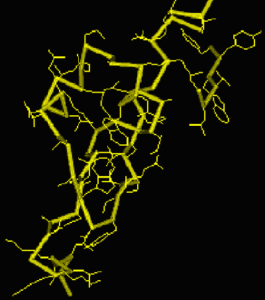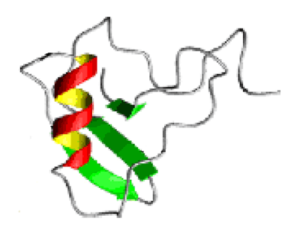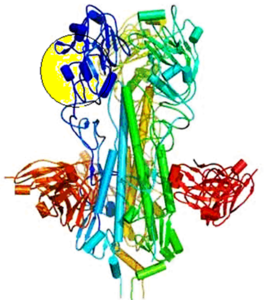| Hemagglutinin (HA) contains a scorpion toxin, binding to voltage-gated sodium Na+ channel: Na+ channel inhibitors as therapy
ISHEID Conf 2010, Toulon France. Poster P168
Guy Mong Ky TRAN 1 Laurent GERBAUD 1 Adrien CAPRANI 2 (1) University of Auvergne, Hotel-Dieu Hospital, Public Health Department, Clermont-Ferrand, France. mkg_tran@yahoo.fr lgerbaud@chu-clermontferrand.fr (2) Association POSITIFS Paris France. positifpresident@yahoo.fr (this work is published FREE on the site)
Aim Despite therapeutic progress in receptor binding inhibition, some deaths continue to occur, especially in young people. We try to find new approaches to fight against Influenza virus resistance. We were interested in Guillain-Barré syndrome (GBS) during the 1976 US vaccination campaign (Haber, 2004, Juurlink, 2006), because Breurec JY in France described a case of GBS after a scorpion sting by a Centruroides noxius species. Scorpion sting is a well known model of pulmonary edema, the hallmark of severe influenza. This raised the question of molecular mimicry between some Influenza virus and scorpion toxin species among the probably >15 000 different toxins. Only a few hundred sequences were known. Methods We compared amino acid (AA) sequences and tridimensionnal structures of Influenza virus A/H1N1 with cysteine-rich scorpion venom toxins (~60 AA long). Results The Influenza virus hemagglutinin globular cysteine-rich region [53 AA long (56-109)] with C59, C72, C84, C107 was aligned in 3 dimensions with scorpion toxin. We specifically align on the 2009 pandemic virus H1N1, the most important at this time. We center on the very characteristic doublet of CXC cysteines, followed by EGL in CXCEGL of toxin CsE V2. Included is Tityus Cambridge Tc49b which possesses the motif TWS with a crucial tryptophan W. An asparagine-linked carbohydrate ([NXT] underlined) is aligned just before the last cysteine C107 encountered in Toxins Cn II-14 III, CssII and Css.
A. HA of pandemic Influenza virus A/H1N1 2009 Mexico (466-VKEYI-462) [ACY77964], Canada-AB (56-109), Japan (246-YYWKLV-251) B. scorpion toxin (AaH II/Cn II-13 VKEGYI) (AaH IT4 YFWKLA) The only sequence matching perfectly with the motif YYWKLA of scorpion AaH IT4 is the motif YYWKLV of Influenza A/H1N1 Japanese strain, among many hundreds of strains in the available Influenza virus Data Bank: Thus this pulmonary edema-inducing Influenza is very rare, probably less than 0, 5%; the majority of pandemic A/H1N1 is not mimicking scorpion venom toxin and are benign strains. As control, non pathogenic and benign Influenza C is very different and cannot be aligned with scorpion toxin. In 3D, there are 2 separated HA patches located very far from each other: One on the HA stem extremity VKEYL (in reverse lecture) and the other remaining on the globular domain (yellow circle in the Figure). When Influenza virus binds and fusions with the cell membrane, these 2 proteins slide along et compacted to form a “constrained” HA and a complete scorpion toxin appears. This looks very like what happens in HIV-1 fusion process (Gallo R, AIDS vaccine, this Conf). A neutralizing monoclonal antibody (in red in the Figure) binds between the 2 patches, at the HA stem conserved middle, inhibiting sterically the fusion. Discussion The finding of a three dimensional scorpion toxin in HA means that Influenza virus binds to the scorpion toxin receptor, i.e. the voltage-gated sodium Na+ channel; in fact, flecainide, a sodium channel ligand, can alleviate experimental auto-immune neuritis induced by P2 myelin protein in Lewis rat (Bechtold DA, 2005), which is a Guillain-Barré model. Many drugs act on the sodium channel: Local anaesthetics (bupivacaine), antiarythmics, antiepileptics (phenytoine), antimalarials, fatty acid omega 3 (Xiao YF, 2006), Tacrine, ginsenoside, lanthanum. Quinine is currently used as an antipyretic against Influenza, but it may by serenpidity be an antiviral by inhibiting the sodium channel. Omega 3 (Omacor®) is particularly interesting, as it is very well tolerated even at high doses and can also be given I.V. (Omegaven®). We propose to test all these Na+ channel ligands in cell cultures to detect if they inhibit Influenza viruses. Bibliography
Influenza A globular Hemagglutinin Scorpion Toxin Hemagglutinin neutralised by antibodies (in red). (William C. Hwang). A patient of Pr Régnier (Hospital Bichat, Paris, France) maintained in artificial coma for weeks/ months.
A patient of Pr Régnier (Hospital Bichat, Paris, France) maintained in artificial coma for weeks/ months. |



 Influenza A globular Hemagglutinin Scorpion Toxin
Influenza A globular Hemagglutinin Scorpion Toxin Hemagglutinin neutralised by antibodies (in red). (William C. Hwang).
Hemagglutinin neutralised by antibodies (in red). (William C. Hwang).

Laisser un commentaire